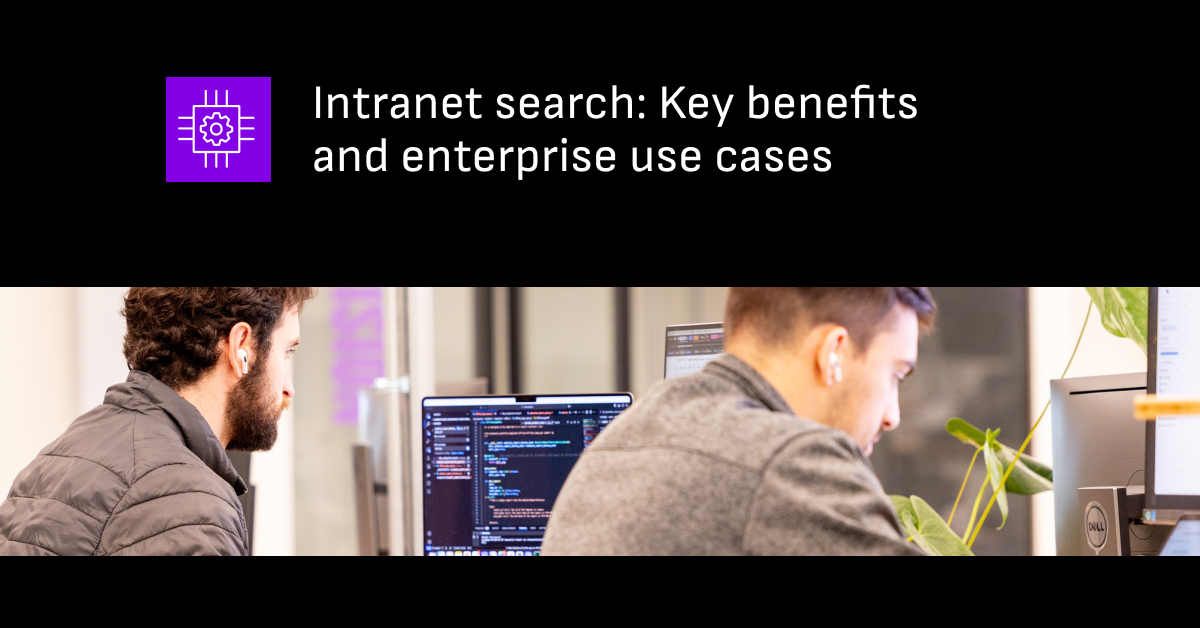When an employee can’t find the answer to a question, it’s more than an inconvenience. It’s a productivity waste.
Employees might waste minutes or hours combing through resources (70% of employees regularly spend an hour or more searching for information). There can then be a ripple effect on other teams’ productivity when the employee reaches out for help. If they can’t find a useful answer, the work might be done incorrectly — or not finished at all.
This wasted time can add up to one major issue: a negative impact on your organization’s bottom line.
A valuable solution to this problem? Intranet search. An intranet search engine keeps internal resources at employees’ fingertips 24/7 so they can complete tasks efficiently and accurately.
What is intranet search?
Intranet search is a specialized software that empowers employees to answer their own questions and quickly locate relevant company documents, information, and resources.
It allows them to search the enterprise’s internal intranet network (a private network just for your company) in the same way they’d search on Google to find a recipe or look up a recent news article.
For an employee, this search experience might involve logging into the intranet portal and typing a keyword (for example, “remote work policy”) into the search bar.
The system would return a list of results: maybe a PDF from HR with remote work guidelines and FAQs about the organization’s remote work best practices from the internal wiki. The employee can then see the information, conduct a related search, or click a contact link for HR if they have additional questions.
Ensuring accurate and updated intranet search results like these involves:
- Regularly indexing all relevant documents
- Integrating advanced search algorithms that consider user context and role
- Implementing metadata and tagging practices that reflect the specific needs and terminologies of the company
The benefits are worth it. When you incorporate artificial intelligence into your intranet, many tasks like these can happen automatically.
How artificial intelligence supercharges intranet search engines
Introducing artificial intelligence (AI) into a company intranet can help to turn basic intranet search into more intelligent enterprise search.
An AI search tool draws on natural language processing (NLP) to better understand search queries, helping it source more relevant information for users. It can also draw data from outside sources or platforms, such as support tickets or emails.
Advanced AI enterprise search tools take it a step further and use ML to learn and improve from user behaviors and search patterns. This allows them to consider context and deliver the most relevant answers for each employee. These tools can also automate indexing and updating, autonomously refreshing old content or even recommending new articles and content to keep knowledge bases current.
Benefits of AI-powered intranet search
One 2024 report revealed that 95% of organizations with AI-powered intranets saw a 50% boost in productivity. In addition to improving employee experiences and productivity, intranet search also helps enable:
- Resource centralization: Centralizes organizational resources for easy employee access.
- Quicker decision-making: Speeds up decisions by providing needed information fast.
- Stronger security: Enhances security through controlled access and monitoring.
- Easier knowledge management and sharing: Simplifies sharing and managing organizational knowledge effectively.
- Reduced IT support load: Decreases IT support needs through streamlined resource access.
6 enterprise use cases for intranet search
An intranet search engine can go a long way for your enterprise team — benefitting more scenarios in the work environment than you might think. Take a look at these six example use cases for an intranet search experience.
1. Quickly finding updated company policies
Employees can use intranet search to find information that’s often scattered across different resources, getting on-demand answers to questions like:
- What’s our company dress code?
- When is the next company holiday?
- What do I do if I need to take an unexpected leave of absence?
This can be extremely helpful if an employee has a situation they’d like to keep private for now, but they still need an accurate answer ASAP. Employees get more autonomy, and management isn’t swamped with questions that can be easily answered.
2. Accessing relevant team resources
Intranet search simplifies access to the latest versions of shared folders, project files, and resources, ensuring that everyone is working from the latest, most accurate information.
For example, say your marketing team is working on a new campaign and needs the latest pricing information for your products. Instead of contacting sales for an updated price sheet (or worse, using an outdated one), they can simply search the intranet to get the exact data they need and see precisely when it was last modified.
The best solutions also provide clear audit trails that show who made what changes and when, as well as access controls to ensure only authorized parties can see sensitive data.
3. Finding individual employee details
An intranet often includes an employee directory with a profile for each team member. Managers, team leads, and HR professionals can use the intranet’s advanced search functionality to locate information like:
- Where a remote employee is based
- Employee birthdays or work anniversary dates
- Individual skill sets and capabilities
This can be helpful in many ways, particularly when it comes to increasing engagement and satisfaction in the workplace. Managers can use this information for employee engagement and recognition (like a birthday gift or work anniversary shoutout) or to assign tasks that better align with each employee’s skills.
4. Enabling IT self-service
Employees can use intranet search to troubleshoot tech issues on their own, helping them resolve problems quickly and independently. For instance, they can identify open support tickets, track the status of unresolved issues, or locate resources about company systems (like instructional videos or step-by-step troubleshooting guides).
This self-service option takes a major burden off IT teams and frees up their time for more high-value, strategic work instead of responding to constant simple requests like password resets.
5. Supporting new employee onboarding
A modern intranet search solution starts new hires off on the right foot by making it easy to find what they need. On-demand access to training resources, company policies, and other onboarding materials ensures they have the knowledge they need to ramp up productivity in their new roles.
A strong onboarding experience also sets the stage for long-term employee engagement and retention. Employees will feel empowered to jump right in, knowing they have the tools they need to succeed.
6. Fostering employee knowledge base usage
A knowledge base — a centralized hub of company information that’s housed on your intranet — is a valuable place for employees to share knowledge across departments. And an advanced intranet search function ensures they can find those resources when they need them.
The more employees use the self-service knowledge base, the more easily they’ll find the information they need. And since advanced AI search engines use ML to identify patterns in user behavior and search results, your AI system is able to improve the more you use it.
Challenges to intranet search (and how to overcome them)
At first, your intranet search solution may need some initial support to get up and running, but fortunately, the right tools and strategies can help to facilitate greater usage and adoption. Below are some challenges you may encounter and tips on how to work through them.
Indexing and updating content
With any intranet solution, it’s crucial to keep the search index updated with the most recent versions of documents and information. Otherwise, you risk employees working from inaccurate data — which could be detrimental in highly regulated industries.
The solution? AI can automate the indexing process and continuously monitor content to enable it to stay up to date. Some advanced search solutions will also cite sources so you can gain transparency and validate your answers.
Search relevance and accuracy
Another common obstacle with traditional intranet search engines is that search results may not be contextually relevant and accurate. They aren’t necessarily meant to address the specific needs and roles of individual users within the organization.
For instance, an HR manager who oversees employee leaves might search for “FMLA guidelines” to understand reporting and compliance requirements. But she receives a general short-term leave policy document and a guide on submitting an FMLA request — neither of which answer her questions.
This is another area where AI can help. Advanced AI-powered search solutions learn from user behavior over time and consider context to better understand search intent. In turn, the search engine can deliver results that are more tailored to the requestor’s role and responsibilities.
If the HR manager repeated her search using an AI-powered intranet search, she might receive documents related to leave of absence procedures, HR compliance, and parental leave requirements.
User experience and adoption
Employees are sometimes reluctant to begin using new technology.
The key to boosting adoption is choosing an intranet solution with an intuitive, user-friendly search interface that caters to varying levels of technical proficiency. With a low barrier to entry, more employees may be willing to try the system.
AI can personalize the search interface based on user preferences and usage patterns, making it more intuitive and leveraging features like predictive search suggestions to further improve user engagement.
Security and access control
Many organizations worry about security (and rightly so). Search results need to comply with the company’s security policies and access controls so that sensitive information is only accessible to authorized personnel.
AI can dynamically manage security policies and flag potential issues in real time, while maintaining audit trails of who accessed what information and when. It can also help ti enforce content classification, which categorizes documents based on their sensitivity level, and use behavioral analytics to flag suspicious user activity.
Best practices for implementing and improving intranet search
Now that we’ve covered the benefits and challenges of finding information on an intranet platform, let’s walk through the tips you need to know for optimal usability when introducing how enterprise search can surface what you need.
Comprehensive and regular indexing
First, you’ll need to ensure all relevant content across your internal sources is regularly indexed so the search database stays up to date. Automated tools or AI can handle this task for you by triggering indexing updates when they detect meaningful changes.
AI can also auto-tag and categorize new content during indexing to improve document discoverability, leading to more robust and relevant search results.
Enhance search algorithms with AI
Together, AI and machine learning (ML) algorithms improve the relevancy, accuracy, and personalization of search results.
On a high level, AI can analyze interactions with search results, leading the search engine to reorder future search results based on which ones receive the most clicks. AI also personalizes results based on the user’s job title and department, pulling up the documents that are most relevant to that person’s role and responsibilities.
AI can even use unstructured data like calendar events and emails to offer helpful content before the user even asks. For example, it might prompt a user to view the latest social media analytics before their upcoming monthly marketing meeting.
User-centric design and personalization
Look for a solution with a search interface that’s intuitive and user-friendly, with features like:
- Natural language: Understand search intent, be able to understand natural language and misspelling, or even fill in the rest of the search term as you type
- Filtering: Narrowing down your search results according to date, department, etc.
- Multilingual capabilities: Especially important for global enterprises and businesses that are quickly scaling.
- Understands your business context: Provides personalization capabilities, allowing you to give the AI information about your company, user roles, and departments. The better the system can understand your specific business environment and needs, the better the employee experience.
Security and compliance management
Any intranet search solution needs robust security measures to ensure that all search results comply with the organization’s security policies and access control protocols.
AI-driven access control and permissions prevent unauthorized access, managing data visibility based on user roles and authorization levels.
Also invaluable are AI-powered data sensitivity and data loss prevention, which are able to flag sensitive data in search results and restrict some content from appearing in queries at all. AI can also help automatically detect documents that are outdated or non-compliant and either flag them for review or update them for you.
Why consider an agentic search solution
To maximize results from your intranet search, consider using a solution that integrates agentic retrieval augmented generation (RAG).
RAG is critical in search, and improves the accuracy of your search by accessing and using knowledge beyond training data. This blend of static and dynamic information enhances the AI’s ability to respond to specific and complex queries.
However, traditional RAG systems face several key limitations, such as struggling with information prioritization, overlooking expert knowledge or a lack of contextual understanding.
Agentic RAG addresses these limitations by introducing intelligent AI agents that autonomously analyze data, make strategic decisions, and perform multi-step reasoning. This approach allows for managing complex tasks across diverse and extensive datasets.
Learn how intelligent intranet search supercharges enterprise productivity
With Moveworks Enterprise Search, rifling through endless (digital) paperwork is a thing of the past.
Moveworks’ agentic RAG solution leverages the powerful Moveworks Reasoning Engine to understand employee goals, develop intelligent plans, and search across various business systems to return useful search results. Moveworks Enterprise Search includes:
- Citations presence that fact-checks for accuracy and links to sources to avoid AI hallucinations.
- 100+ pre-built connectors that integrate Moveworks Enterprise Search across your information repositories, plus APIs for custom connections.
- Granular permissions and access controls to ensure the right employees have access to the right information (and nothing more).
- Flexible data volume and variety support to seamlessly accommodate growth.
- Robust analytics to help stakeholders track adoption and usage.
We leverage agentic AI to turn enterprise search into a dynamic, intelligent, goal-oriented knowledge management system — one that checks its results for accuracy before providing an answer to the user. That’s what helps our search engine deliver the trustworthy, accurate answers employees are actually looking for.
Ready to experience modern intranet search for yourself? See Moveworks Enterprise Search in action!
Table of contents



